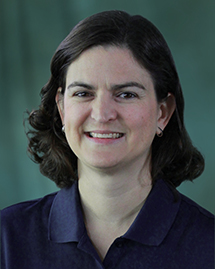Seminars
Prof. Stephanie TerMaath
Mechanical, Aerospace, and Biomedical Engineering Department
University of Tennessee, Knoxville
A Distributed Dislocation Technique to Model Fatigue Growth of Kinked Surface Microcracks in Aluminum Alloys

ABSTRACT: Prediction of fatigue crack growth in non-straight, complex surface crack arrays typically requires high fidelity analysis using computationally expensive methods to account for the mathematical and geometrical complexities inherent in the solution. A dislocation distribution based technique (DDT) has been previously demonstrated to rapidly and accurately predict the stress intensity factors for through cracks of complex shape. This method is expanded to predict the fatigue crack growth rate of surface cracks and investigated as an approach for rapidly predicting crack growth in kinked and tortuous surface crack arrays, using the surface crack configuration and bulk material properties as inputs. To investigate the accuracy and effectiveness of this predictive method, surface crack growth in AA7075-T7351 was experimentally analyzed and modeled under high cycle and low cycle fatigue conditions. Cracks were measured using a high resolution surface replication technique and then modeled as either kinked or straight surface cracks. These experimentally determined crack configurations and corresponding loading conditions were then input into a method to predict fatigue crack growth rate, and the results from kinked and straight crack models were compared. The experimental and predicted crack growth rates were found to correlate well, and the inclusion of crack kinking resulted in a 13% improvement to crack growth rate predictions. The dislocation distribution based method was determined to be a computationally expedient and valuable tool for predicting the crack growth of non-planar crack configurations.
BIOGRAPHY: Dr. Stephanie C. TerMaath, PE* is an Associate Professor and the Zeanah Faculty Fellow at the University of Tennessee, Knoxville in the Mechanical, Aerospace, and Biomedical Engineering Department. Her Computational Mechanics research group develops numerical methods and algorithms to solve complex, multi-physics problems and implements these new techniques into simulation codes. Her funded research projects encompass damage tolerance analysis of composite patch systems, optimization of ventricular catheter design, variability reduction in additive manufacturing, and joining of dissimilar materials. Before joining the faculty in the fall of 2012, she managed a physics-based computing group at Applied Research Associates (ARA). She previously held positions at Boeing Phantom Works and Lockheed Martin Aeronautics where she worked on numerous programs, including the High Speed Civil Transport, 737, 777, C-17, Delta IV, and Joint Strike Fighter. (*NC Professional Mechanical Engineering License 033553)